Designing towards the Unknown: Engaging with Material and Aesthetic Uncertainty
Abstract
:“Alchemy is the old science of struggling with materials, and not quite understanding what is happening.”[1] (p. 19)
1. Introduction
2. PKI: Motivations
2.1. Conceptual Drivers
- How to give people the feeling of being in someone else’s body, someone with perhaps very different abilities and constraints.
- How designers might effectively prototype advanced material interactions, where the characteristics of the materials in question might not yet be concretised.
- How designers and scientists might effectively cross-fertilise research-in-process with public opinions around the social, ethical, personal, political and cultural implications of what life would be like if yet-to-be-concretised technologies were readily available, and part of people’s lives.
- Develop new forms of embodied and wearable interactions that challenge participants’ notions around terms such as: ability, disability, body typical and normative or normal.
- Expand the ways that we, as design researchers, engage with technological potential.
- Investigate how design actions might afford productive cross-fertilisation of social imaginaries and concerns with scientific development, and
- Ascertain whether, or how, doing so might productively influence perceived social relevance of research.
2.2. Theoretical Drivers
3. PKI: Crafting Design Interactions
3.1. Weaving a Way Forward
- Phase I began with motion capture experiments with four alternately-abled creative professionals, and culminated in open, participatory actions with diverse publics;
- Phase II involves closer collaboration with materials scientists and engineers, and further open experiments.
3.2. Two Looms
3.2.1. Loom 1: Australia
- Green Knits (Figure 1): graspable structures that emerged directly from research into biotensegrity—the interplay of compression and tension in the human body [25]. These probes serve as a material guide for moving, as well as understanding how to move, linking the cognitive with the kinaesthetic and proprioceptive in unexpected ways
- Blue Cushions (Figure 2): felted wool lumps that serve as sweet deformities or temporary scars that can be put on and taken off at will. These probes place pressure on different muscle groups and nerve pathways to change perception of movement.
- Sleeves (Figure 3): curious partial-garments that alter movement pathways through the imposition on the wearer’s body of a hidden or constantly shifting maze.
3.2.2. Loom 2: Denmark
- Embodied paper prototypes (Figure 4): dynamic forms developed through an embodied prototyping process (This probe-set was developed by Mary Karida and Erica Vannucci, students at The University of Southern Denmark). Each form opens and closes in various ways, depending on how they are placed on the body and how the wearer moves. The purpose of this probe-set is to investigate (a) how participants might engage with forms that can be placed anywhere on the body, and (b) whether doing so might impact a persons’ understanding of the body in movement, and in what way.
- Creatures + Straps (Figure 5): diverse knitted elements. The Creatures are inspired by transparent marine animals that—like alien creatures—can hug the body in different ways, and in doing so dynamically alter their form. These shape change capabilities were informed by the embodied paper prototyping experiments (described above), the possibilities and constraints afforded by machine-knitting 3D structures, and our Phase I findings (reported at [21]). The Straps are inspired by kinbaku-bi—a form of Japanese bondage that focuses on the aesthetics of tying, knotting and constraining the body [31], again informed by our findings from Phase I. This probe-set represents a series of aesthetic leaps, and is conceptually far more sophisticated than the other probe-sets in this loom.
- Sensors + Sounds (Figure 6): hand-made textile stretch sensors patched into a computer running the Max sound programming environment. These sensors were aesthetically matched to the sea creatures, as they were originally intended to form part of the same probe-set. We kept them separate for two reasons. First, we wanted participants to determine in what ways the different probe-sets might be paired, without being guided by our prompting. Second, by separating sonic feedback from the visual and physical feedback provided in probe-sets (1) and (2), we hoped to observe how participant behaviour might differ in response to the different sensorial trigger. The sonic interactions of this probe-set were developed by students from The University of Southern Denmark (SDU) and Kolding Design School (From the SDU: Ferran Altarriba Bertran and Mirzel Avdic; from Kolding Design School and Tongji University College of Design and Innovation: Yu Keyu; with additional technical support provided by: Jonas Leonas (Kolding Design School)).
- Craft’s soft logic provides a framework that both supports and suggests alternative ways of working that are open and flexible, yet robust. The confidence this robustness engenders supports risk taking in us researchers and, we believe, the participants in our design actions.
- The social and performative nature of craft acts as a rich site for inviting and opening up exchanges of ideas [27].
- Exposing an audience to relatively unformed research, and researchers to audience responses at early stages of the work is effective (if not always satisfying).
- The level of commitment a participant brings to their participation with experimental probe-sets, is coupled to both conceptual resolution and ease of use.
- Warping a metaphorical loom with conceptually and materially uneven probes can challenge participants’ ability to engage with the unresolved nature of the work, whereas series of prototypes, developed to a similar level of conceptual or material sophistication, better affords triangulation, and therefore structure and engagement.
3.3. Metaphorical Cloths of Gold
4. Reflections
5. Conclusions
Supplementary Materials
Acknowledgments
Author Contributions
Conflicts of Interest
References
- Elkins, J. What Painting Is; Routledge: London, UK, 1999. [Google Scholar]
- Ingold, T. Bringing Things Back to Life: Creative Entanglements in a World of Materials. ESRC National Centre for Research Methods; NCRM Working Paper Series 15; Realities/Morgan Centre, University of Manchester: Manchester, UK, 2010; pp. 1–15, (Unpublished). Available online: http://eprints.ncrm.ac.uk/1306/ (accessed on 25 December 2017).
- Haraway, D. How Like a Leaf: An Interview with Thyrza Nichols Godeve; Routledge: New York, NY, USA; London, UK, 2000. [Google Scholar]
- Rosner, D.; Ikemiya, M.; Kim, D.; Koch, K. Designing with traces. In Proceedings of the ACM Conference on Human Factors in Computing: CHI 2013, Paris, France, 27 April–2 May 2013; ACM Press: New York, NY, USA, 2013; pp. 1649–1658. [Google Scholar]
- Pollard, J. The art of decay and the transformation of substance. In Substance, Memory, Display: Archeology and Art; Renfrew, C., Gosden, C., DeMarrais, E., Eds.; McDonald Institute for Archaeological Research: Cambridge, UK, 2004; pp. 47–62. [Google Scholar]
- Jonas, W. Design research and its meaning to the methodological development of the discipline. In Design Research Now: Essays and Selected Projects; Michel, R., Ed.; Birkhäuser: Basel, Switzerland, 2007; pp. 187–206. [Google Scholar]
- Sanders, L. On modeling: An evolving map of design practice and design research. Interactions 2008, 15, 13–17. [Google Scholar] [CrossRef]
- Mäkelä, M. Framing (a) practice led research project. In The Art of Research: Research Practices in Art and Design; Mäkelä, M., Routarinne, S., Eds.; University of Art and Design: Helsinki, Finland, 2006; pp. 60–85. [Google Scholar]
- Ingold, T. Walking the plank: Meditations on a process of skill. In Defining Technological Literacy; Dakers, J.R., Ed.; Palgrave Macmillan: New York, NY, USA, 2006; pp. 65–80. [Google Scholar]
- Wilde, D.; Underwood, J.; Pohlner, R. Crafting Material Innovation. In Proceedings of the Design Research Society Special Interest Group: Experiential Knowledge, EKSIG 2015, Kolding, Denmark, 25–26 November 2015; pp. 21–33. Available online: http://experientialknowledge.org.uk/proceedings_2015_files/EKSIG2015_Proceedings.pdf (accessed on 25 December 2017).
- Adamson, G. The Craft Reader; Berg: Oxford, UK, 2010. [Google Scholar]
- Braidotti, R. Transpositions; Polity: Cambridge, UK, 2006. [Google Scholar]
- Fox, N.; Alldred, P. Sociology and the New Materialism: Theory, Research, Action; Sage: London, UK, 2016. [Google Scholar]
- Braidotti, R. The Posthuman; Polity: Cambridge, UK, 2013. [Google Scholar]
- DeLanda, M. A New Philosophy of Society: Assemblage Theory and Social Complexity; Continuum: London, UK, 2006. [Google Scholar]
- Latour, B. Reassembling the Social: An Introduction to Actor Network Theory; Oxford University Press: Oxford, UK, 2007. [Google Scholar]
- Bennet, J. Vibrant Matter: A Political Ecology of Things; Duke University Press: Durham, UK; London, UK, 2010. [Google Scholar]
- Van der Tuin, I.; Dolphijn, R. The transversality of new materialism. Women Cult. Rev. 2010, 21, 153–171. [Google Scholar] [CrossRef]
- Hird, M.J.; Roberts, C. Feminism theorises the nonhuman. Fem. Theory 2011, 12, 109–117. [Google Scholar] [CrossRef]
- Lindström, K.; Ståhl, A. Patchworking Publics-in-the-Making: Design, Media and Public Engagement. Ph.D. Thesis, Malmö University, Malmö, Sweden, 2014. [Google Scholar]
- Wilde, D.; Underwood, J.; Pohlner, R. PKI: Crafting critical design. In Proceedings of the ACM Conference on Designing Interactive Systems, DIS2014, Vancouver, BC, Canada, 21–25 June 2014; ACM Press: New York, NY, USA, 2014; pp. 365–374. [Google Scholar]
- Harris, J. 5000 Years of Textiles; The British Museum Press: London, UK, 2004. [Google Scholar]
- DeLanda, M. Material complexity. In Digital Tectonics; Leach, N., Turnbull, D., Chris Williams, C., Eds.; Wiley: Hoboken, NJ, USA, 2007. [Google Scholar]
- LeAmon, S. Curator, Melbourne Now, National Gallery of Victoria, International, Melbourne. 2014. Available online: http://www.ngv.vic.gov.au/melbournenow (accessed on 6 August 2017).
- Schleip, R.; Findley, T.; Chaitow, L.; Huijing, P. (Eds.) Fascia: The Tensional Network of the Human Body: The Science and Clinical Applications in Manual and Movement Therapy; Churchill Livingstone Elsevier: London, UK, 2012; pp. 154–196. [Google Scholar]
- Gordon, B. Textiles, the Whole Story, Uses, Meanings, Significance; Thames and Hudson: London, UK, 2011. [Google Scholar]
- Ravetz, A.; Kettle, A.; Felcey, H. (Eds.) Collaboration through Craft; Bloomsbury: London, UK; New York, NY, USA, 2013. [Google Scholar]
- Gaver, W.; Sengers, P.; Kerridge, T.; Kaye, J.; Bowers, J. Enhancing ubiquitous computing with user interpretation: Field testing the home health horoscope. In Proceedings of the ACM SIGCHI Conference on Human Factors in Computing: (CHI ’07), San Jose, CA, USA, 28 April–3 May 2007; ACM: New York, NY, USA, 2007; pp. 537–546. [Google Scholar]
- Sennett, R. The Craftsman; Penguin: London, UK, 2009. [Google Scholar]
- Design Research Society Special Interest Group: Experiential Knowledge. In Proceedings of the EKSIG 2015, Kolding, Denmark, 25–26 November 2015; Available online: http://experientialknowledge.org.uk/conference_2015.html (accessed on 6 August 2017).
- Midori. The Seductive Art of Japanese Bondage; Greenery Press: Emeryville, CA, USA, 2001. [Google Scholar]
- Redström, J. Making Design Theory; MIT Press: Cambridge, UK, 2017. [Google Scholar]
- Gale, C.; Kaur, J. The Textile Book; Berg Publishers, Bloomsbury: Oxford, UK; London, UK, 2002. [Google Scholar]
- McCullough, M. Abstracting Craft, the Practiced Digital Hand; MIT Press: Cambridge, UK, 1996. [Google Scholar]
- Adams, B. Crafting capacities, chapter introduction. In Design as Future-Making; Yalavich, S., Adams, B., Eds.; Bloomsbury Academic: London, UK; New York, NY, USA, 2014; pp. 18–24. [Google Scholar]
- Goett, S. Materials, memories and metaphors: The textile self re/collected. In The Handbook of Textile Culture; Jefferies, J., Wood Conroy, D., Clark, H., Eds.; Bloomsbury: London, UK, 2016; pp. 121–136. [Google Scholar]
- Ingold, T. Making culture and weaving the world. In Matter, Materiality and Modern Culture; Graves-Brown, P., Ed.; Routledge: London, UK, 2000; pp. 50–71. [Google Scholar]
- Jefferies, J. Editorial introduction. In The Handbook of Textile Culture; Jefferies, J., Wood Conroy, D., Clark, H., Eds.; Bloomsbury: London, UK, 2016; pp. 3–16. [Google Scholar]
- Lindström, K.; Ståhl, A. Patchworking ways of knowing and making. In The Handbook of Textile Culture; Jefferies, J., Wood Conroy, D., Clark, H., Eds.; Bloomsbury: London, UK, 2016; pp. 65–78. [Google Scholar]
- Appaduri, A. Forword. In Design as Future-Making; Yalavich, S., Adams, B., Eds.; Bloomsbury: London, UK; New York, NY, USA, 2014; pp. 9–11. [Google Scholar]
- Yelavich, S.; Adams, B. (Eds.) Design as Future-Making; Bloomsbury Academic: London, UK; New York, NY, USA, 2014. [Google Scholar]
- Dewey, J. Art as Experience; Berkley Publishing Group, Penguin Group: New York, NY, USA, 2005. [Google Scholar]
- The Poetic Kinaeshtetic Interface Project. Available online: http://www.daniellewilde.com/embodied-futures/pki/ (accessed on 6 August 2017).
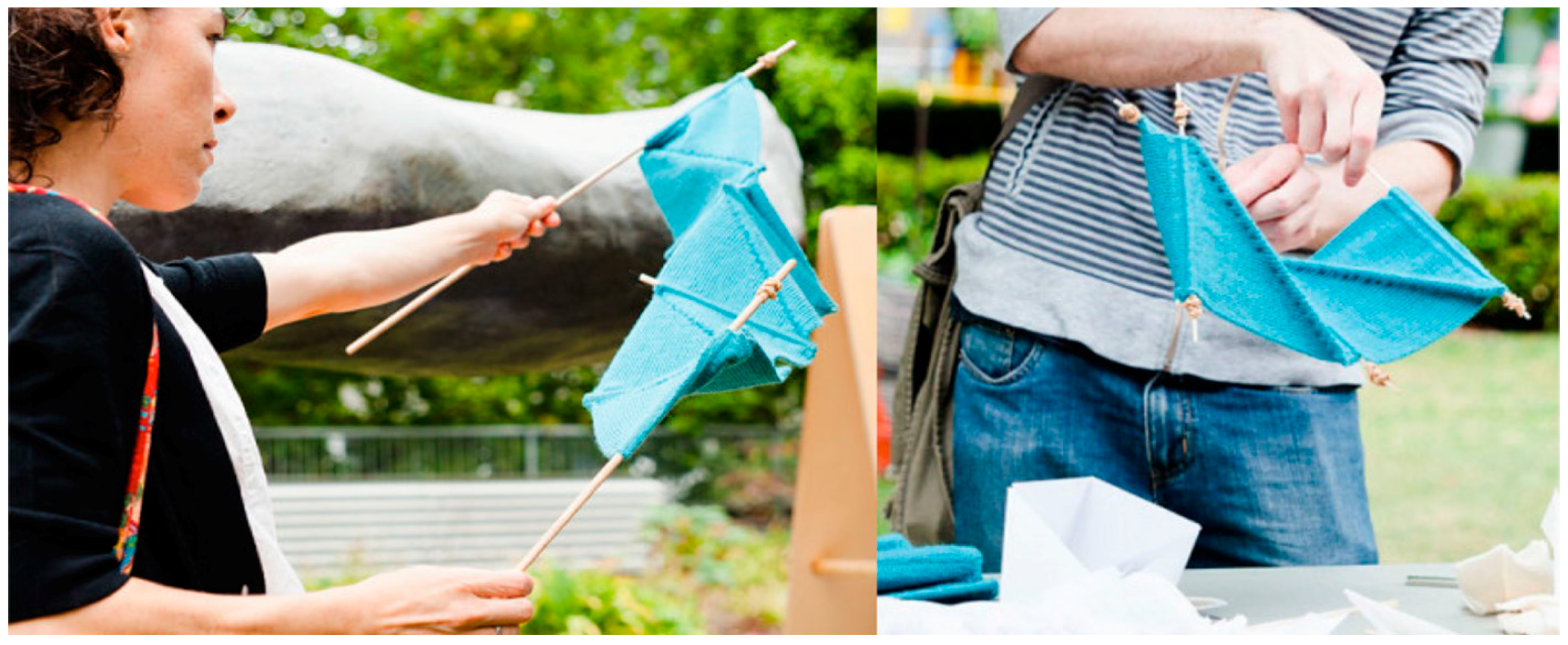

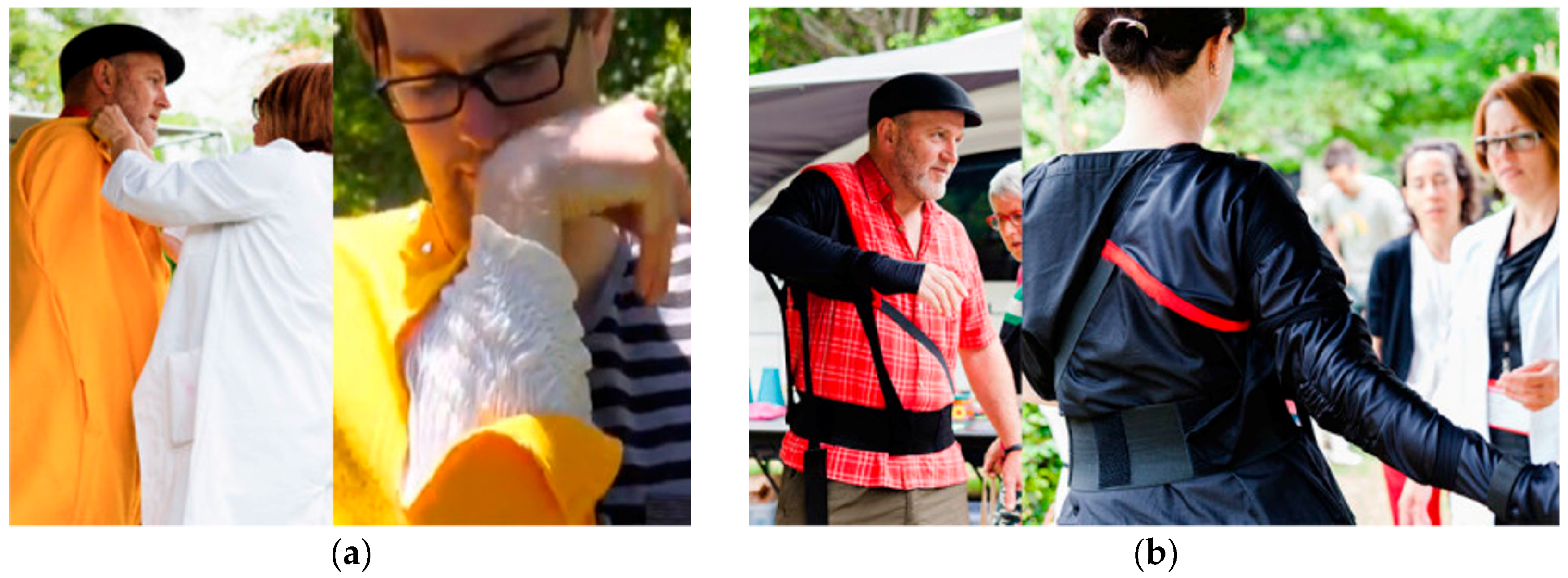
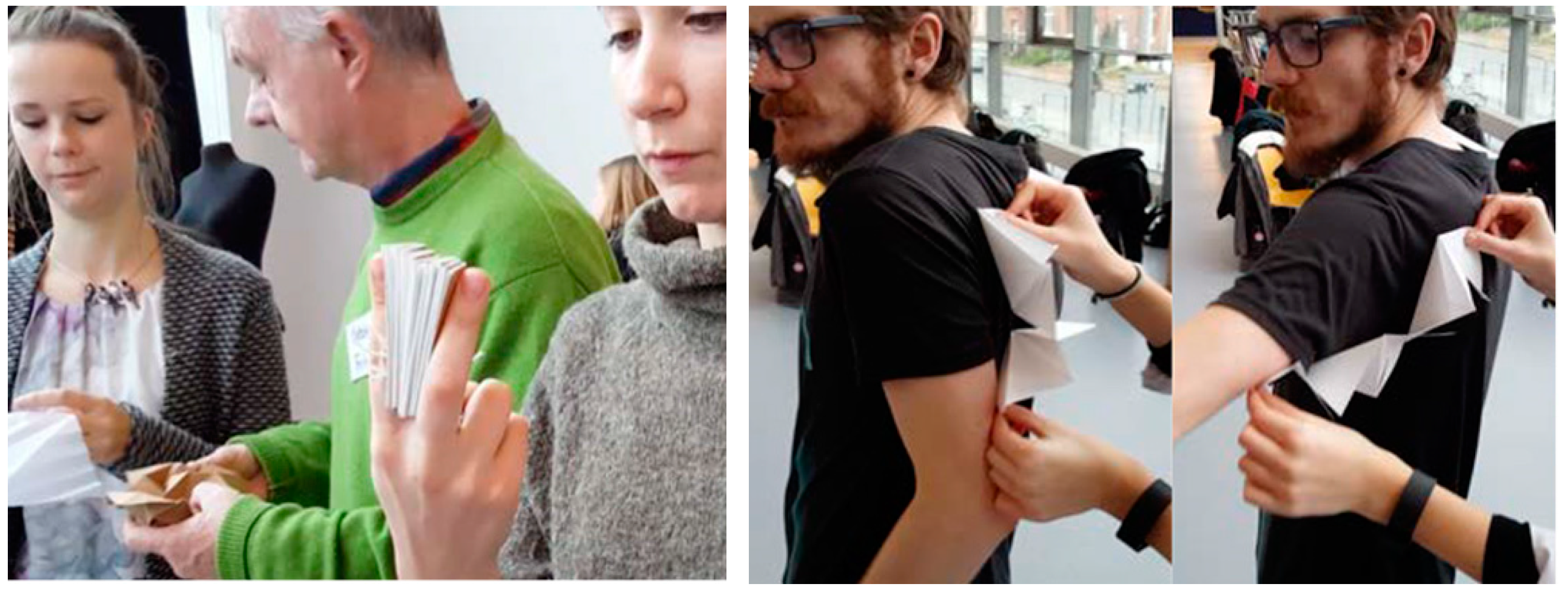
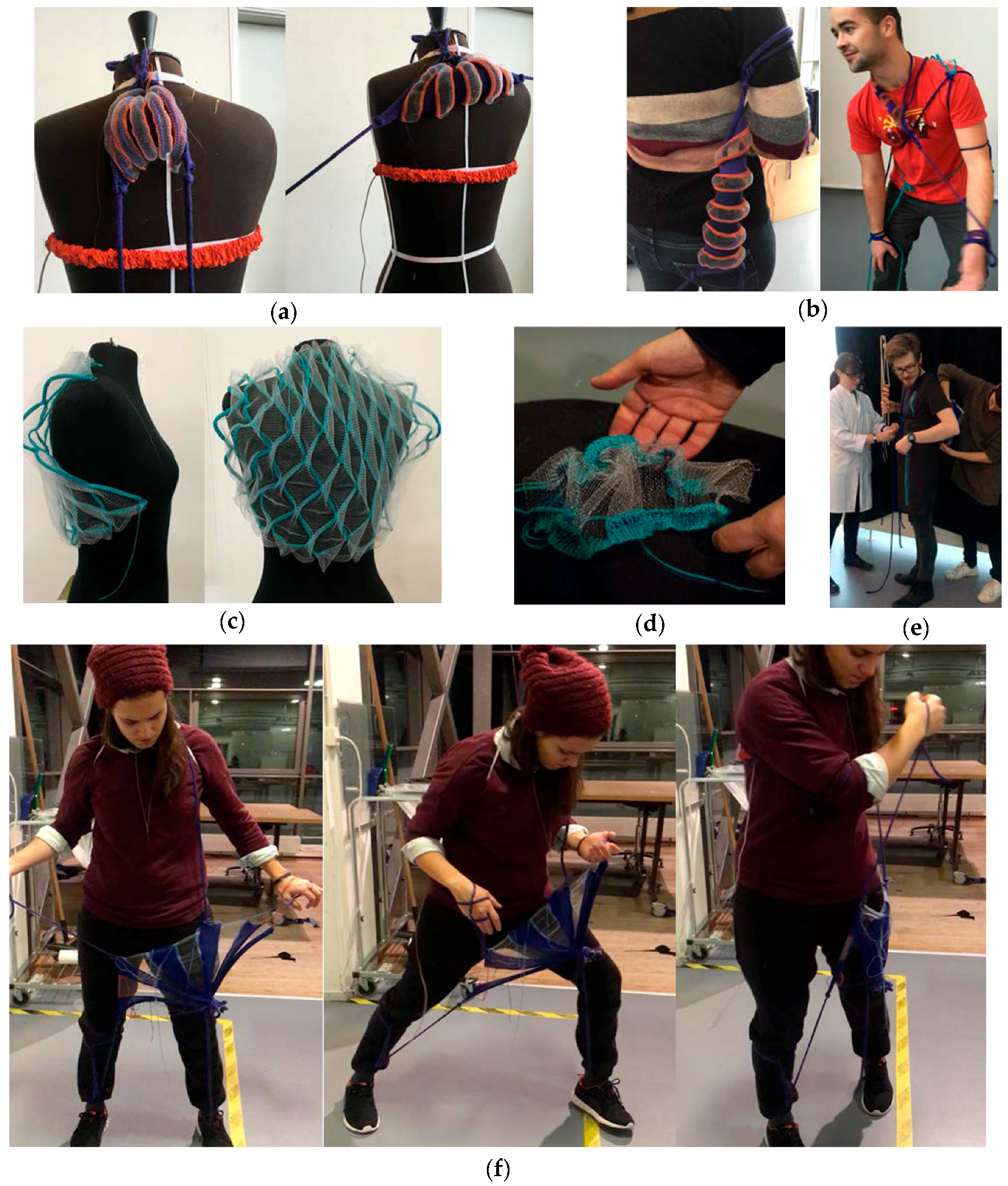
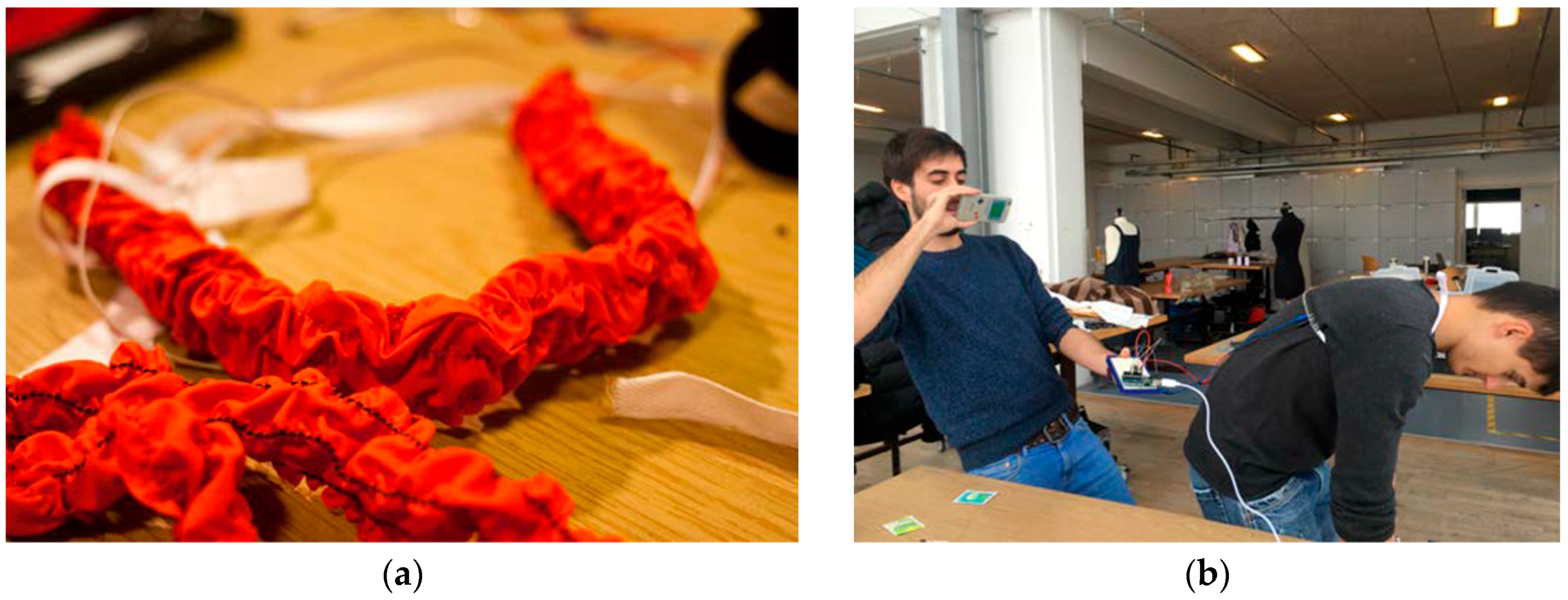
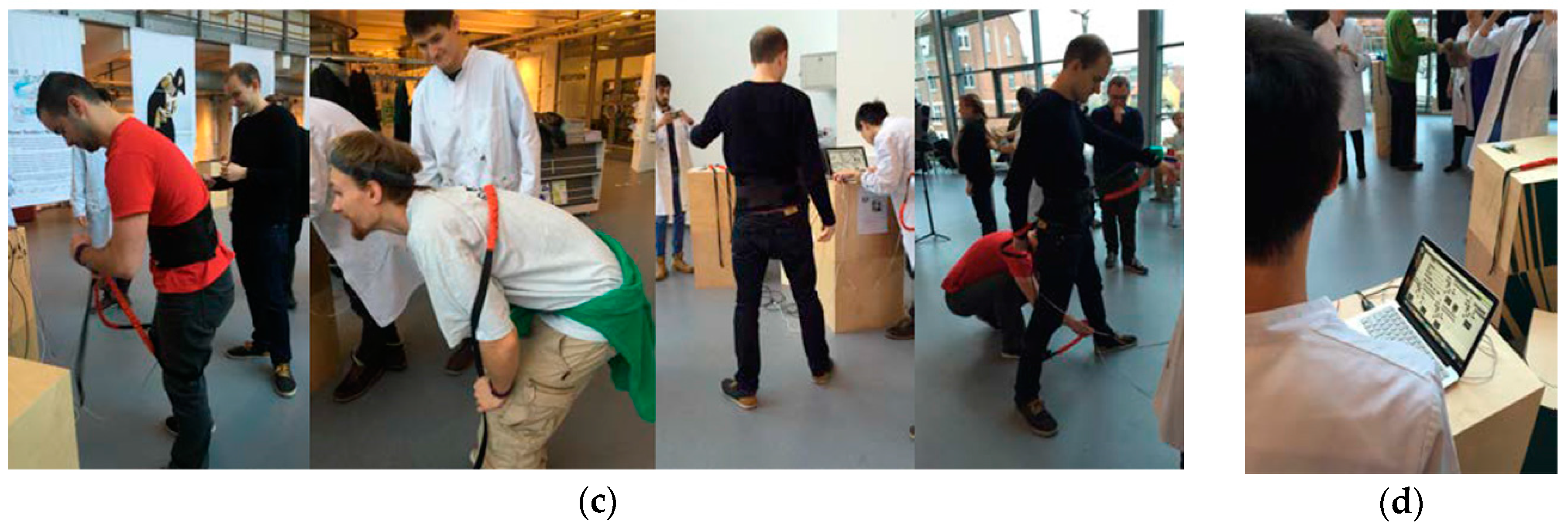
© 2017 by the authors. Licensee MDPI, Basel, Switzerland. This article is an open access article distributed under the terms and conditions of the Creative Commons Attribution (CC BY) license (http://creativecommons.org/licenses/by/4.0/).
Share and Cite
Wilde, D.; Underwood, J. Designing towards the Unknown: Engaging with Material and Aesthetic Uncertainty. Informatics 2018, 5, 1. https://doi.org/10.3390/informatics5010001
Wilde D, Underwood J. Designing towards the Unknown: Engaging with Material and Aesthetic Uncertainty. Informatics. 2018; 5(1):1. https://doi.org/10.3390/informatics5010001
Chicago/Turabian StyleWilde, Danielle, and Jenny Underwood. 2018. "Designing towards the Unknown: Engaging with Material and Aesthetic Uncertainty" Informatics 5, no. 1: 1. https://doi.org/10.3390/informatics5010001
APA StyleWilde, D., & Underwood, J. (2018). Designing towards the Unknown: Engaging with Material and Aesthetic Uncertainty. Informatics, 5(1), 1. https://doi.org/10.3390/informatics5010001




